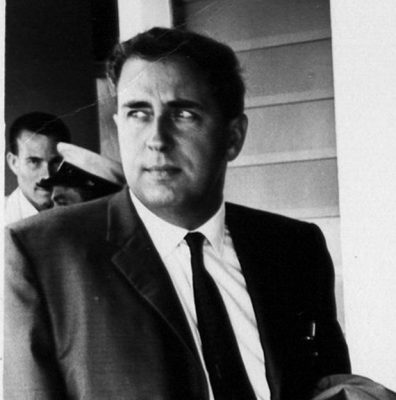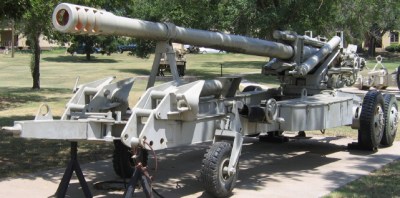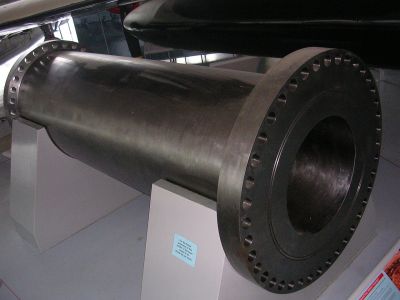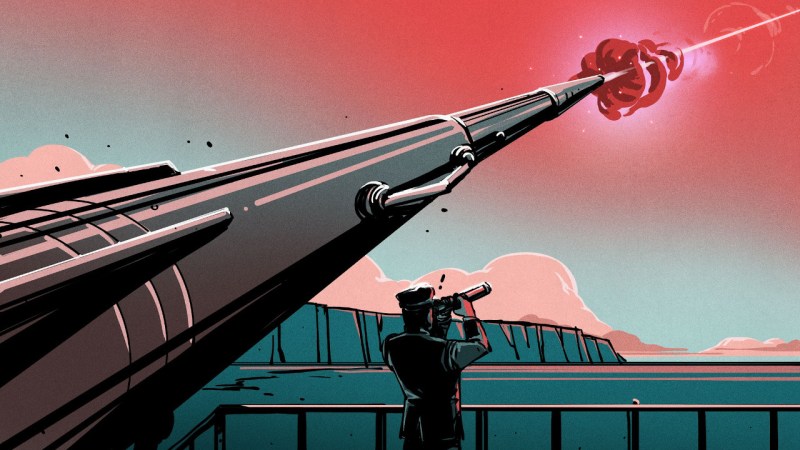In the annals of ambitious engineering projects, few have captured the imagination and courted controversy quite like Gerald Bull’s Supergun. Bull, a Canadian artillery expert, envisioned a gun that could shoot payloads directly into orbit. In time, his ambition led him down a path that ended in both tragedy and unfinished business.
Depending on who you talk to, the Supergun was either a new and innovative space technology, or a weapon of war so dangerous, it couldn’t be allowed to exist. Ultimately, the powers that be intervened to ensure we would never find out either way.
First Shots Fired

Gerald Bull was born in 1928 in Ontario, Canada. After a tumultuous youth, his uncle was able to find him a place at the University of Toronto at the age of sixteen. Where his uncle suggested the medical school, Bull requested a position in the newly established aeronautical engineering course. After passing an interview, he was able to begin his tertiary studies in the field at the age of sixteen.
He would go on to graduate in 1948, a strictly average student that had done little to distinguish himself during his period at the university. However, his energy and passion would eventually see him admitted to further study at the Institute of Aerodynamics, where he studied the design of advanced wind tunnels.
This academic pursuit laid the groundwork for his future endeavors. While finishing his PhD in 1950, Bull would eventually be nominated for military work with the Defence Research Board. That led to his position with the Canadian Armament Research and Development Establishment, where he dived into the world of advanced artillery technology.

He began exploring the use of artillery guns for supersonic aerodynamic research, as a cheaper alternative to building high-speed wind tunnels. Later on, he would go on to develop the High Altitude Research Project (HARP), a joint Canadian-American initiative aimed at exploring ballistics at extremely high altitudes.
Kicking off in the 1960s, HARP’s most notable achievement was the creation of a massive gun capable of firing projectiles into the stratosphere, setting the stage for Bull’s lifelong obsession with superguns.
His early experiments with HARP demonstrated the potential of using artillery to reach the upper atmosphere, though the project was eventually shuttered due to financial and political pressures. The project developed a 16.4 inch (41.6 cm) smooth-bore gun which was installed for testing in Barbados.
By 1962, HARP was firing 330 pound (150 kilogram) finned projectiles at over 10,000 feet per second (3000 m/s), reaching altitudes of 215,000 feet (65 kilometers). The project was funded by using the projectiles to capture meteorological data in the upper atmosphere.
Aiming Higher
The seeds for Bull’s later work on the infamous Supergun were sown during these formative years. His desire was not just to shoot projectiles into the upper atmosphere, but to fire them so fast that they could actually reach orbit. His idea to achieve this was simple — he’d use a large gun to fire a projectile high into the atmosphere, where it would then ignite a rocket to boost its velocity further.

Well, simple enough on paper, anyway. But achieving this feat was altogether more complex in reality. Bull began investigating the concept during his time at the HARP project. There, he developed rocket-assisted projectiles that could be fired from an artillery gun without damage to the solid fuel propellant.
Plans centered around a small multi-staged rocket called the Martlet. It was to be fired from a 16.4 inch (41.6 cm) gun that was assembled by joining two existing naval cannons together into one massive barrel a full 110 feet (33.5 meters) long. Sadly, HARP’s funding began to dry up towards the end of the 1960s, and a change of government sealed the project’s fate.
Bull ended up going out on his own, establishing the Space Research Corporation (SRC) to pursue his goals. The company operated as an artillery consultancy for international clients, including the Canadian and US military. He developed improved rifling techniques which helped give military artillery longer range and better accuracy. SRC and Bull would go on to sell shells and guns to states all around the world. On the side, he continued to develop his orbital gun technology.

The culmination of Bull’s work came in the late 1980s with the Supergun project. After serving jail time in the US for dealing arms to South Africa, Bull had moved away from clients in the West, and had taken up work with China and Iraq. Ultimately, though, this gave him the opportunity to pursue his dream of an orbital launch gun once more.
Officially known as Project Babylon, it was commissioned by Saddam Hussein in 1988, while he was then the Iraqi defense secretary. The project’s goal was ostensibly to develop a supergun capable of launching satellites into orbit, potentially reducing the cost and complexity of space launches. The guns were intended to fire multi-stage rocket propelled shells that would be capable of reaching orbit.
Bull agreed to continue work on conventional military artillery pieces for the Iraqi government, in exchange for a $25 million payment towards Project Babylon. The project would see the construction of multiple “Baby Babylon” guns, each measuring 147 feet (44.8 meters) long with a caliber of 13.8 inches (35 cm).
Big Babylon
The ultimate goal, however, was the production of two mighty PC-2 Big Babylon guns. They would measure 512 feet (156 meters) long with a massive 39 inch (99 cm) bore. The PC-2 was intended to be capable of launching a 440 lb (200 kg) satellite into an orbital trajectory, carried by a 4,400 lb (2,000 kg) rocket-assisted projectile. Alternatively, it could have launched a 1,300 lb (600 kg) projectile over 620 miles (1,000 km). The final gun would have sat almost 328 feet (100 m) high at the tip, with the barrel suspended by cables from a large supporting frame. The barrel itself was to weigh 1,510 tons, with the whole structure coming in at a hefty 2,100 tons in total.

The technical challenges were immense. Achieving the necessary muzzle velocity to reach orbit required unprecedented gun lengths and extremely durable materials to withstand the immense pressures involved. The initial construction of the Baby Babylon revealed problems with seals between multiple barrel segments. This was a complication from a a necessary engineering decision, as producing a single barrel at such large sizes was impractical.
Meanwhile, the political implications of the project drew international concern. Given the fraught political situation at the time, a large Iraqi gun project was not popular on the international stage. On paper, the gun’s applications for military use were limited. It was not possible to readily aim the gun, nor could it fire rapid salvos on a given target. It was impossible to move or hide, and it was extremely vulnerable to air attack.
Regardless of these practical limitations, few countries wanted Iraq to have such a potent gun in any way, shape or form. Furthermore, Bull was continuing to work on other Iraqi artillery projects, including Scud missile development. This only made him more unpopular with Iraq’s enemies.
The project’s demise was as dramatic as its ambition. In 1990, Bull was assassinated in Brussels as he approached his apartment’s front door. It followed a series of break-ins to his home, which were suggested to be a threat to the engineer to cease his work on the project. His death effectively ended Project Babylon. Supergun components, which had been in production across Europe, were seized by customs officers, and Bull’s staff in turn abandoned the project. Parts of the gun still exist today, after being donated to museums in the UK.
In the aftermath, the Supergun project remains a fascinating study of the interactions between ambition, technology and politics. Gerald Bull’s legacy is a testament to the limits of engineering, and the limits of our own ruling structures. While technically feasible, the Supergun could not be born, given the perceived geopolitical ramifications of such a weapon.
Gerald Bull’s story is a poignant chapter in the history of space exploration technology, marked by brilliant engineering marred by political intrigue and a tragic end. It serves as a reminder of the complexities involved when mixed-use technologies clash with political interests and national security concerns.
















The discussion I’d really like read—one that would satisfy both my down-to-earth engineer and my sky-high futurist dreamer—is: What would it take for single-stage-to-orbit (SSTO) to become a reality? Like… Chemical rockets can provide X thrust, but you’d need Y to loft say… two humans, a life-support system, (and maybe a comfortable toilet). Every moviegoer saw Boba Fett’s modest-sized “flatiron” personal starship, and believed it will be possible, but what would he truly need… a fusion reactor to make it go whoosh into orbit? (To irreverently mix universes, we can skip the part about lightspeed and dilithium crystals.)
The math on this is not hard. You do not need thrust (well, you do, but it is not the primary factor) you need “delta V”.
So https://en.m.wikipedia.org/wiki/Tsiolkovsky_rocket_equation applies.
Then you need Isp, wet and dry mass (mass of the rocket with and without fuel). Isp and weight of common rocket engines as well as fuel use numbers should be not that hard to find.
OR, you install kerbal space program, install the realism overhaul mods, and just try it.
Except low thrust delta-V when you’re not in an orbital configuration results in gravity and drag losses. Similarly low thrust delta V when you’re far out of a gravity well isn’t as efficient due to the Oberth effect.
It isn’t as efficient to raise your perigee at a high apogee, but it sure takes a lot less total delta-v from up there to get your perigee out of the atmosphere. So a bit easier to fit on a projectile in the form of solid fuel. I wonder just how much altitude it would be possible to get out of one of those guns.
SSTO is feasible today, though not financially viable compared to traditional rockets. But, it’ll never look or work like in Star wars/trek because rockets require fuel and lots of it.
Maybe fusion engines would do it, but those are at least a hundred years away from being built.
Project orion was tested with chemical explosives and verified to be practical. Some believe that the nuclear blast would ablate the pusher plate but i saw a comment saying that if the plate was coated with oil before each blast then longevity would be greatly increased.
With such a propulsion method you would try to use the type which produce the least amount of fallout.
It’s an interesting idea for a sci fi novel, suppose that the birth rate wasn’t regulated and climate change caused the planet to become uninhabitable and antisocial, why not build a generation ship to have a better start.
Why wait?
Start today.
True fact: Donald Trump IS J.R. ‘Bob’ Dobbs incarnate.
I like the sentiment, but ultimately it would be more practical and more likely to succeed to build a generational ship and simply leave it on Earth somewhere. The best approach would be to do both.
“Silo” on Apple.TV
I can’t picture oil passages or sprinklers oiling the shield without getting trashed in a hurry, so you would need to have robots or crew come out, scramble to oil down the shield, then get back to the other side before setting off the next nuke. As if Project Orion needed to get any crazier.
Because even in those circumstances it’s probably less work to fix the planet we have then move somewhere else (and likely have to adjust the environment there for our needs).
Space travel is almost certainly not the answer for overpopulation.
What you need for that is a portal to an empty parallel earth ready for colonization.
Had literally covered that in incredible detail like a week ago
.
https://hackaday.com/2024/05/20/single-stage-to-orbit-the-launch-technology-we-wish-was-real/
I like that for now, the handwave idea (the need for much more powerful and efficient propulsion) is to wait for fusion engines that will apparently be used in-atmosphere.
Well you could basically do that now with fission engines. “But won’t that be dirty and spew radiation everywhere?” Yes, so would fusion engines. “But I thought fusion was the clean nuclear??” Not really if you want power densities appropriate for propulsion.
We could probably convert something like Project Pluto into an SSTO-capable vehicle pretty easily. Use the nuclear ramjet in atmosphere and then cool the core with onboard propellant once the atmosphere becomes too sparse. And God help anybody under your flight path. And if you run out of propellant too soon, your ship becomes a rapidly-expanding ball of white-hot ionized alloys that will make Chernobyl seem like a really bad fart in comparison.
Fusion would be similar in flight, it just wouldn’t leave as long-lasting fuel waste (which isn’t much of a concern in space anyway). Well.. It would be advantageous to be able to turn it off much quicker.
Needs a banana for scale.
…which is funny because it *is* bananas.
He should have simply spun his gun in a huge tilted vacuum chamber before firing, that surly would have been enough to get the payload up to speed…
You mean what Spinlaunch is trying to do?
Yea but only adding a gigantic cannon that also spins. How hard could it be?
+1
If you want a super canon that history forgot, the German V3 :
https://en.wikipedia.org/wiki/V-3_cannon
You, sir, beat me to it! 👍
Similar
https://www.spacedaily.com/news/future-00q.html
Now, I would want a borehole using this tech:
https://m.facebook.com/nwtls/videos/watch-as-petras-remarkable-thermal-bore-cuts-through-undrillable-rock/338270524970158/
The barrel matches the slope of the Andes mountains—stretching from summit to sea floor.
Heavy equipment on a platform above…breech loading zone above sea-level…muzzle exit out of summit.
Evacuate to vacuum—the sea your charge.
I thought he also developed “base bleed” technology for artillery shells.
Didn’t Jules Verne use a huge cannon in earth to the moon? Something like that? And that old timey film where the shuttle gets stuck in the moon’s eye like in the Smashing Pumpkins video?
Yup.
“Considering that Gerald Bull was working on the Iraqi Super-gun, Iran and the Mossad are the most obvious culprits.
For less obvious reasons, MI6, the CIA, and even the South African intelligence services, may also have decided to terminate Gerald Bull.
Today, the MOSSAD is usually regarded as the “official” culprit. Although it makes sense, I am far from convinced.
Many people, beside the usual suspects, had a very good reason to want Gerald Bull dead.
Among others, this list includes Lady Thatcher and a few folks from the Belgian Deep State.”
From https://inteltoday.org/2020/03/22/30-years-ago-gerald-bull-is-assassinated-in-brussels-march-22-1990/
^^ when the potential list of people who might want you dead is that long, maybe you need to reassess your life choices before it’s too late.
https://en.wikipedia.org/wiki/Arms-to-Iraq_affair#Matrix_Churchill
There are also claims that a director of Matrix Churchill, the company that made the Supergun sections, was working for British intelligence services. The UK MoD helped them apply for export licences in a way that would circumvent restrictions on arms sales to Iraq.
Didn’t we have some aligned interests (Iran) with them in the 80’s?
Yes. Saddam Hussein had plenty of Western help in his rise to power in the 1980s.
South African Intelligence services? Really? LOL
It was Mossad.
I mean, if I had to bet on it, I would bet on the foreign murder squad of the people the supergun was pointed at too.
Mossad are good enough to add flourishes.
For example Stuxnet.
‘They’ reran the stuxnet ‘event’ in a carefully constructed virtual space.
When the Iranian ultracentrifuges ‘spontaneously self disassembled’ they did so to the beat of ‘Hatma’, the Jewish traditional song.
Out of a payload that went to the controllers of less than 1k bytes the Mossad did the math and included a nice tune.
It is a Very Good Thing™ that Iran doesn’t have a nuclear bomb, and I very much hope it stays that way, not least for the ordinary people who live there and hate their government.
But let’s be honest, it wouldn’t take three guesses to work out who they would threaten with it (just before it’s located and turned into a big hole in the ground).
“they did so to the beat of ‘Hatma’, the Jewish traditional song”
That’s not mentioned in the excellent, very detailed documentary on Stuxnet entitled “Zero Days.” I doubt it since, although the culprits were fairly obvious due to their incentives, they did much to hide the origin in their code. Also, their method was to destroy the centrifuges while the readings on monitors remained normal. If a Jewish song played, that would be a serious clue that something wasn’t right.
This was my understanding, a higher/faster failure rate that was harder to diagnose, rather than a series of booms.
You guys are no fun.
I choose to believe.
Exploding Blue Danube.
https://youtu.be/zP8Kah6vXsQ?si=1pX9JScQlvq8-XVY
Why would Thatcher (AKA The Iron Lady) want to assassinate the bloke buying gun parts from her son? That would seem counter productive regardless of the desired outcome.
If there’s a long list (or even a short one) of people who want you dead, it’s already too late.
Dear HaD: this his probably the best bit of writing you’ve done in a long time- and there has been some really good stuff on here.
Great detail on a relatively obscure bit of technology, in detail and answering all the big questions without dumbing down too much but still accessible to a more general audience. and covered the political implications without any seeming major bias of which there could have been some enormous pitfalls .
.
Seriously great job-
Assassinated is such an anodyne term for murder, but that is what happens to people living in democracies who won’t play ball. Might is right.
It’s a subset of murder, but you’re right, at the end of the day all governance eventually boils down to who has the monopoly on legitimated physical violence. That has to be the final arbiter of disagreement, no matter how many layers of civil procedure come before
Even the UN recognizes the right of self defense.
No monopoly on legit physical violence exists.
Play ‘danger seeker’, you’ll find out what ‘fighting words’ means. https://youtu.be/Uwk6r8TJD2U?si=ph0xGZMypwR53AYt
Granted they expect you to defend yourself with a pool noodle or banana. Not so much as a pointed stick.
I can assure you plenty of people who don’t live in democracies also get assassinated
DAS RITE
I read the novel by Frederick Forsyth. The Fist of God or something like that.
I’m thinking that’s where the notion that Iraqis killed Bull was discussed. He allegedly had loose lips and Israelis used him to get info. So that might’ve been the reason for Iraqis to take him out.
What about the German V3:
https://en.m.wikipedia.org/wiki/V-3_cannon
Although it was not meant to reach space.
Maybe the Paris Gun
https://en.wikipedia.org/wiki/Paris_Gun
would be a better German gun when talking about Bull since he did write a book on it.
Iraq had started digging the tunnel they were going to install their version into.
Guess what? It didn’t point east. Rather to the W-NW.
Apparently they were going to launch into a retrograde high inclination orbit. First track passed south of Lebanon.
Shame that Bull was never able to get to shoot satellites into space. It would be much more efficient to shoot a lot of small satellites into orbit with a gun than launch them on rockets, I’m looking at you Elon.
One problem with this and spin launch is the accelerations that the satellite would have to survive. Rockets accelerate gradually to orbital speed, meanwhile they are dropping mass due to staging and propellant burn off. Spin launch and the cannon concept both require maximum speeds at launch unless you use booster rockets in which case, why not just use all rockets.
Spin launch could accelerate more gradually than a rocket. It all depends on the acceleration of the rotation.
True, but that only applies when you’re launching soft, squishy things like people. Satellites can easily be made to withstand thousands of g’s, and while it might be more slightly more expensive to build the satellites, it’s a hell of a lot cheaper than throwing away huge rockets. Gun launch could be a serious niche in the launch market.
It seems like the velocities that don’t put all your launch energy into turning you into compressed plasma from trying to go hypersonic in the lower atmosphere are low enough that the peak altitude before you absolutely must fire rockets is within the range of cheaper things like balloons. Or a hypothetical supersonic high altitude plane, if you’re going to build something to let you begin thrusting with some velocity on your side instead of just altitude.
There is a company, SpinLaunch, that is developing a centrifugal rocket launcher… it spins around very fast it to give the rocket initial velocity, to the tune of 2km/s, saving fuel. They even built the thing. I don’t know if it has been flight tested.
Had covered this in a feature article not long ago as well. The comments section was… not kind.
https://hackaday.com/2022/06/24/spinlaunch-and-the-history-of-hurling-stuff-into-space/
Forgot the link
They built a prototype, not the full-scale design. I recall seeing a video of their big successful test, where they managed to hurl a metal football into the air, already spinning wildly almost as soon as it left the apparatus. I’m not holding my breath.
There is also the “Slingatron” concept that has been kicking around since ~2012. It seeks to accelerate objects around a spiral track that is being eccentrically excited. Basically a mechanical version of a synchrotron.
https://patents.google.com/patent/US6014964A/en
https://arc.aiaa.org/doi/abs/10.2514/2.5311?journalCode=jpp (abstract only, paper is paywalled)
Lewin, the end of your post has a paragraph of the form, “X is a poignant chapter in the history of Y, marked by Z. It serves as a reminder of ABC.”
This summary form is popular in various YouTube shorts. Perhaps in other locations, too. After hearing it many times, it seems like something generated by a machine. Or maybe such a summary is taught in schools now. Or something else? Would you satisfy my curiosity?
Sounds like another Wernher von Braun.
Shame the HaD article didn’t get into the technical details.
From article – “Achieving the necessary muzzle velocity to reach orbit required unprecedented gun lengths and extremely durable materials to withstand the immense pressures involved. ”
The brilliance of the design was that it did NOT require the otherwise immense pressures of a traditional gun.
In a traditional gun, the breach end will experience the highest pressures in a very short period thus requiring the thickest steel. Pressure decreases exponentially as the projectile travels down the barrel. As guns get larger or projectiles faster, the wall thickness of the breech becomes silly thick and exponentially less thick near the muzzle.
The SuperGun improved this by giving each barrel segment it’s own powder charge and fired them in sequence down the barrel. Each charge’s characteristics were unique for that stage. So for example, very slow burning, low-pressure powder for the breach segment, very fast burn for the final muzzle segment. The projectile would experience a constant pressure down the entire barrel.
Bull envisioned boring holes in solid stone mountains to eliminate most of the cost of the barrel. A metal liner with periodic ports and service tunnels for the powder charges could be used. This would allow much longer guns, higher pressures, lower accelerations at relatively low cost. I think it’s a great idea considering that a nuclear power plant could provide steam to get most of the initial acceleration for practically free.
It’s safe to say, he was pretty bullish about the project.